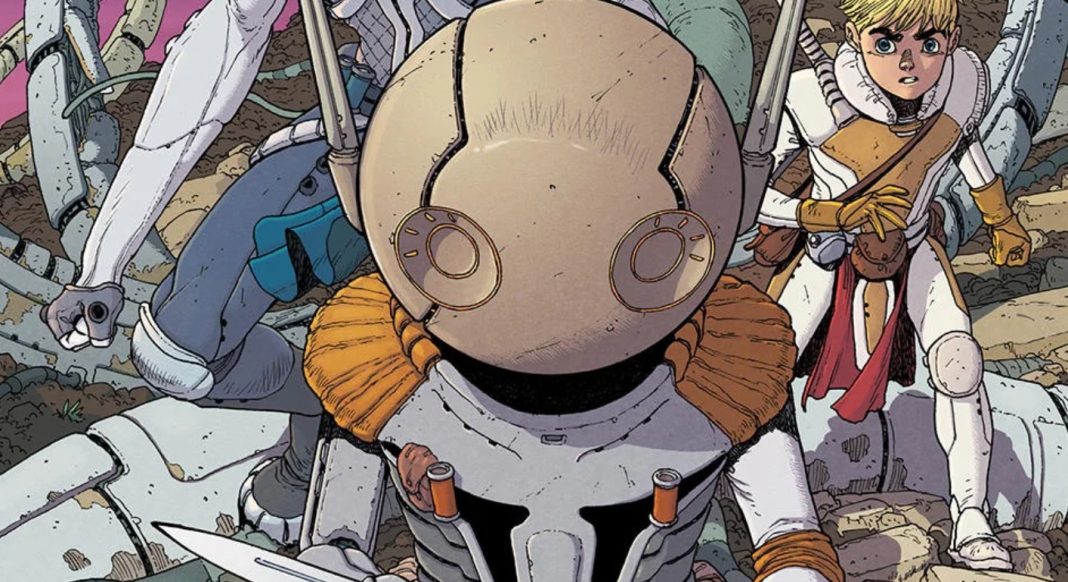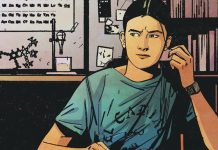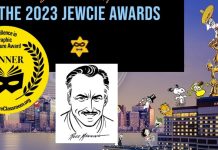Brian Michael Bendis and André Lima Araújo did not know what they were making when they started on the project that eventually became Phenomena, Book One: The Golden City of Eyes, an original graphic novel that hit shops this week.
The creators had been working together at DC Comics, and they’d found a great creative chemistry. So, Bendis asked Araújo what else he was working on, what his goals were, and what he’d like to do next. Araújo shared sketches, designs, and pitches with Bendis, a glut of them he’d done over the years, none of which were intended to be connected. Araújo just sent it that way, all at once.
“By doing it that way, I saw it as all one thing,” Bendis recalled during a recent conversation with The Beat. “It was all one big André world that I wanted to live in, to write in, and I came back and said, ‘What if this was all one big thing?'”
They started to form their story from there, realizing about halfway through that what they had was actually a YA adventure, a quest story, with three characters moving through the intricate and striking landscapes, architecture, and technologies that define Araújo’s singular work. They looked back over the comics they had so far made, and found that they only needed to make one change — there was a panel in which a character was giving the middle finger. And that needed to be edited out (edited digitally, by the way, meaning that Araújo still has the original page for any interested collectors…).
“I was really tortured by it, because I made my bones putting F-words in Marvel Comics,” Bendis said. “In Jessica Jones, the first word is the F-word. That fact that I was going, ‘I don’t know, this seems a little rough’, was a very strange feeling to me.”
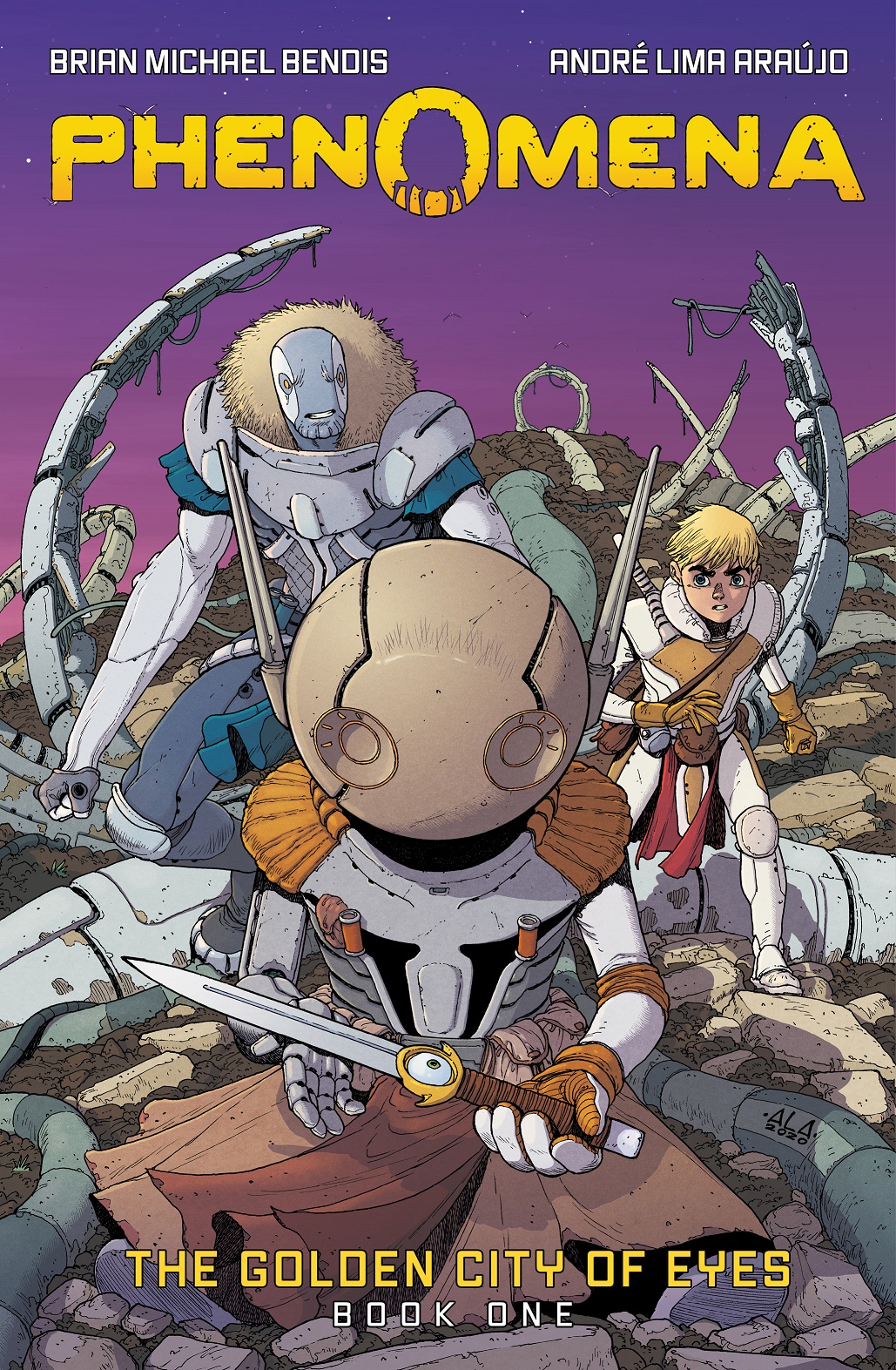
From a certain perspective, this book represents a lot of other changes for the veteran creator too, and not just for Bendis but for Araújo as well. The foray directly into YA work is new for them, and both have also primarily told stories through single issue comics, so the switch to a full, book market-aimed graphic novel is new, too. The result, though, is stunning, a book that seems just as likely to engage young readers as it does students of comics craft.
And the duo recently made time to talk about all of this, as well as their processes in creating this book (the first of a trilogy), with The Beat. The conversation — which has been edited for length and clarity (and also because my dog was barking so loud at one point that we had to talk about it) — can be found below.
Bendis, Araújo Talk Phenomena Book One
Zack Quaintance: Can I start by asking how this project first came together?
Brian Michael Bendis: It started when I saw André’s work over at Marvel. When I came over to DC, I reached out. When we started cooking on Legion of Super-Heroes, André was high on my list, because I wanted to see Legion drawn by André. At the same time, I wanted to see if we would work well together. So, we did a few small pieces at DC, and it was what I hoped it would be. I reached out and said, ‘Hey! What are you thinking, what are you doing, what do you want, what are your goals?’
He sent me material he’d been working on over the last few years — designs, pitches — and I had a unique opportunity to look at all of it at once, because that’s how he sent it. By doing it that way, I saw it as all one thing. It was all one big André world that I wanted to live in, to write in, and I came back and said, ‘What if this was all one big thing?’
We started building the world, and I came in and started the jibba jabba. It was a unique way to collaborate. Merging our unique energies as creators was a lot of fun, and as we kept going, we were discovering what we had as we went. We didn’t know this was a YA adventure until we were halfway through. From there, we said, ‘Let’s see if the bookstore market is interested in something like this.’ Abrams was the perfect place.
André Lima Araújo: It was really a cool thing. Brian came up with that grand idea, and the only thing putting it together was making sure the style went together. Brian asked me for a boy and a creature, and those were the only things he asked me for. He really let me do my thing, and I sent my stuff to him so he could do his thing. It was very satisfying for me, because I could create something visually that was connected without much of a plot. I was particularly blown away with the way he was dealing with my designs, how he was picking and choosing from the things I sent. I didn’t tell him what the characters were because I didn’t know. I just sent him the art.
Zack: André, I thought the landscapes in this book were really stunning. For lack of a more eloquent way of phrasing it, did those just sort of fall out of your head?
André: They fell out of my head in a way. The way we were doing it, I didn’t know what the characters were going to be. I knew what I wanted it to look like, and I knew what I would love to be trying. That’s how I chose. That’s why you have castles mixed with technology, or Roman ruins like on the cover. That was from a photograph. Like with any project, I went through pictures and concept art, and I kept thinking about movies and videogames that I like. I mixed it all up together, visually, never taking anything from one place. The only rule was if Brian says, ‘I’m not feeling this,’ we don’t use it, and if I want to take something out, we don’t use it.
Now that we’re working on Book Two, we go back to Book One if we need to, but so far we are mostly working on new stuff. We had Toronto in the first volume, and for that, I used a photograph that shows the city well, and I drew some buildings from the city so that it’s recognizable. Then I start drawing stuff that I like. For example, I went through concept art from the video game Mass Effect. I see a building I like there — I pick things I enjoy drawing.
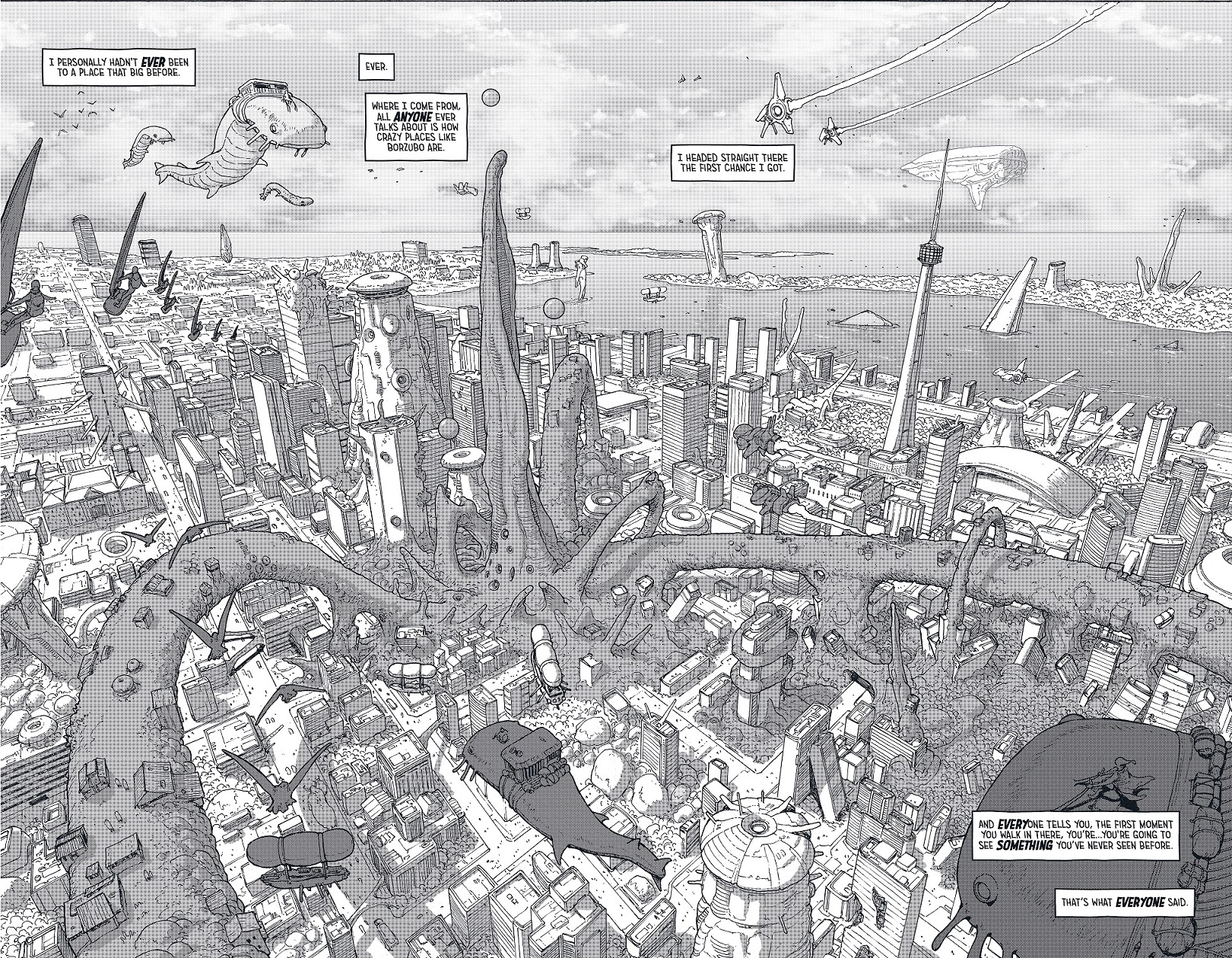
Brian: What he’s describing and what we figured out early is that our energies separately are unique. I’m addicted to collaboration, and looking at every collaboration differently. Walking into this one, I realized early on that my job is to prompt André to be André. It was not to give him a list of things that I want. What I want is for him to go nuts. Everything I write should be just enough for him to feel tethered to the story, and everything else is me getting out of the way.
There’s been quite a few collaborations like this over the years in comics that I’ve been aware of. I remember very clearly reading about Frank Miller and Geof Darrow’s original collaboration on Hard Boiled. It was very different than Frank’s other collaborations. I remember reading that he realized his job was introducing Geof Darrow to the world, and all he should be doing is getting out of the way. I took that as inspiration here. Frank always is an inspiration for something, and for this one in particular, I thought I was in a similar situation, working with an illustrator of such a high caliber with such beautiful design. It’s a balancing act of how can I prompt him to do that which he wants to do, and at the same time tell a cohesive story.
André: It wasn’t a situation where I’m drawing everything, and Brian just comes in at the end and puts in a few words of dialogue. That’s not how it goes. I give him all this art, and he builds plot and dialogue. The way I then draw everything, but especially the characters and how I animate them, is very much informed by the way he writes them, the dialogue he gives them, and what he chooses, which has been one of the marvels for me. I could draw a book like this on my own, but it would not read like this because it’s very different than what I would do with the plot and dialogue. The richness comes from the collaboration. I’ve been drawing and re-adapting my designs — not in terms of changing many things but in the terms of the way Brian sees them as well.
Zack: One very specific thing I wanted to ask about was the book has its own vernacular that makes it seem like its own world. How did you develop that?
Brian: I’m such a big fan of the audience’s intelligence. You want to offer a way into the world that’s exciting but not insulting. Also, that language has changed, but not so much that you’re lost. Even if you don’t understand what every word means, you understand what its intention is. It’s a balancing act. There were dozens of nitpicky drafts. Literally, moving a word from one balloon to another balloon can change everything.
Even in the opening scene, the only thing that tells you this is earth is two words — pomegranate and Toronto. ‘Oh, there’s a pomegranate? This is earth.’ I think that’s enough. I think everything else falls into place once you go, ‘Oh, this is earth!’ Something has happened, everyone seems okay, there are monsters running around, and everyone seems to be dealing with it. Then as the story goes, more and more hints are dropped about what has happened, why it’s happened, and what it means to everybody.
It’s very easy to write, ‘Once upon a time in the world of Phenomena…’ Anyone can do it. Lovely books and movies have done it in the past, but also a lot of garbage books and movies have done it in the past, and I’m allergic to them. So, it’s can we balance the uniqueness of this world by dropping people right into it and letting them look around.
Zack: It really does trust the reader to come along as the story unfurls, which was a great choice for a YA-skewing audience. I think they’re better at that than most adults.
Brian: I 100 percent agree. You know, as I said earlier, we were making this on our own before we realized we had a YA adventure similar to Bone or Avatar: The Last Airbender. Once we realized what we had, we decided to lean into it and see what we could bring that was special to that space.
I was surprised to find myself in that space. I came into comics as a hard-boiled crime writer. All of a sudden, now I go into Barnes & Noble, and there’s Miles and RiRi and Naomi all in the YA section. The beautiful beautiful beautiful YA section of graphic novels that’s in all bookstores that did not exist 10 years ago, and here we are planting good energy right in the middle of that. I was looking at all the other books in the section — the Captain Underpants and the Rainas (Telgemeier) — and there were still flavors left to add. There are more beautiful ways to show them what comics and graphic novels are capable of.
André: One of the joys of this collaboration was discovering that we were making a YA book when we were in the middle of it, because we didn’t know. We didn’t set out to do that, which was cool because it allowed us to work without boundaries. The only thing we remade was one panel from the book where we had a character showing the finger. We realized it didn’t feel right, and it was Brian who picked it up because I’m so into the drawing, panel-to-panel.
At first I couldn’t see it. Then I looked at the page in sequence, and he was absolutely right. Even then, we didn’t discuss YA. We didn’t know until we went to Abrams and were trying to sell the book to a publisher.
Brian: I was really tortured by it, because I made my bones putting F-words in Marvel Comics. In Jessica Jones, the first word is the F-word. That fact that I was going, ‘I don’t know, this seems a little rough’, was a very strange feeling to me. But every character has its own energy, and every character lets you know what it needs.
Zack: You both have kids, have you shared the book with your children yet?
André: I have twin daughters who are 1-year-old, so they have no idea what a book is.
Brian: I don’t think that’s an excuse! I think you should sit down and tell them how important dad is!
André: [Laughs]. I’ll tell you a story about my oldest daughter, who is four years old. Between Book 1 and Book 2 of Phenomena, I’ve been drawing Righteous Thirst for Vengeance. It’s a very different book from this one, very violent. Through the time I was drawing that book, she grew up, and she was starting to ask many many questions. So I’m relieved now that I am back working on Phenomena. I don’t have to explain anything weird to her.
Brian: My children are older, so I have learned over time how to balance it. Some of my work is out there in pop culture. Their friends are wearing Miles Morales t-shirts to school. So, I try to balance it. While I don’t talk about my work to them at all, ever, at the same time, if it’s something I think they’re going to see, or Naomi is going to be on TV…I just try to balance it so we’re not talking about dad’s career all the time. I probably go too far the other way.
What I’ve learned over the years, is I just leave the books laying around, so if they gravitate to them out of their own curiosity and they say anything, I invite that conversation. I’m also curious if it’s interesting to them. In this one, my son is very aware that Golden is kind of based on him and Matilda is kind of based on André’s older daughter. We have a lot of family energy in this book as well. I don’t want to tell him it’s him, but it kind of is. The voice is his, even if he’s never been in this situation and it’s not his truth. So, it’s a weird relationship my kids have with this stuff.
My youngest was on Zoom a couple months ago with another kid, and he asked the other kid, ‘So, where does your dad keep his million comics? Don’t you have a room for your comics?’ The kid goes, ‘We don’t have any comics.’ It just then occurred to my son this is a weird house, and this is not how other people live.
Phenomena, Book One: The Golden City of Eyes is out now, and can be purchased online.


